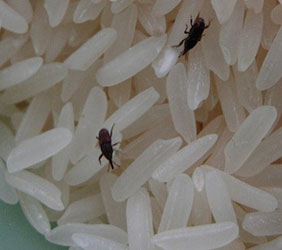Rice Weevil
 Sitophilusoryzae is only 3 mm long, but it can cause quite a lot of damage despite its small size. The blackish-brown rice weevil, which was inadvertently introduced from the tropics, can be identified by the four square-shaped orange markings on its wing cases.
The females like to lay their 100 to 200 eggs in cereal grains, but barley & pasta can also be infested. They breed particularly well in warm temperatures. They gnaw a hole in the cereal grain, lay one egg per grain and then seal the opening with a secretion. The egg develops into a larva and then into a pupa in the shell of the grain.
Sitophilusoryzae is only 3 mm long, but it can cause quite a lot of damage despite its small size. The blackish-brown rice weevil, which was inadvertently introduced from the tropics, can be identified by the four square-shaped orange markings on its wing cases.
The females like to lay their 100 to 200 eggs in cereal grains, but barley & pasta can also be infested. They breed particularly well in warm temperatures. They gnaw a hole in the cereal grain, lay one egg per grain and then seal the opening with a secretion. The egg develops into a larva and then into a pupa in the shell of the grain.
Depending on the temperature, the growth cycle takes one-and-a-half to six months. The beetle itself can survive without food for several months.
A cereal grain infested with the rice beetle looks completely normal from the outside. The larvae eat up the grains, leaving behind the empty shells. Infested cereals become warm and soon become musty, and subsequent pests can also cause additional losses.
Preventive measures and controls
• Insecticides should not be used in food-storage cupboards or in the direct vicinity of food
• Infested food should be removed and destroyed immediately
• Thoroughly vacuum cupboards using the crevice tool of a vacuum cleaner, paying particular attention to cracks and crevices
• Wipe out cupboards with a damp (never wet) cloth and allow to dry completely. Leave the doors open for a while
• Store newly purchased food in sealed containers. The basis rule is: Store food in a cool, dry place
 Sitophilusoryzae is only 3 mm long, but it can cause quite a lot of damage despite its small size. The blackish-brown rice weevil, which was inadvertently introduced from the tropics, can be identified by the four square-shaped orange markings on its wing cases.
The females like to lay their 100 to 200 eggs in cereal grains, but barley & pasta can also be infested. They breed particularly well in warm temperatures. They gnaw a hole in the cereal grain, lay one egg per grain and then seal the opening with a secretion. The egg develops into a larva and then into a pupa in the shell of the grain.
Sitophilusoryzae is only 3 mm long, but it can cause quite a lot of damage despite its small size. The blackish-brown rice weevil, which was inadvertently introduced from the tropics, can be identified by the four square-shaped orange markings on its wing cases.
The females like to lay their 100 to 200 eggs in cereal grains, but barley & pasta can also be infested. They breed particularly well in warm temperatures. They gnaw a hole in the cereal grain, lay one egg per grain and then seal the opening with a secretion. The egg develops into a larva and then into a pupa in the shell of the grain.
Depending on the temperature, the growth cycle takes one-and-a-half to six months. The beetle itself can survive without food for several months.
A cereal grain infested with the rice beetle looks completely normal from the outside. The larvae eat up the grains, leaving behind the empty shells. Infested cereals become warm and soon become musty, and subsequent pests can also cause additional losses.
Preventive measures and controls
• Insecticides should not be used in food-storage cupboards or in the direct vicinity of food
• Infested food should be removed and destroyed immediately
• Thoroughly vacuum cupboards using the crevice tool of a vacuum cleaner, paying particular attention to cracks and crevices
• Wipe out cupboards with a damp (never wet) cloth and allow to dry completely. Leave the doors open for a while
• Store newly purchased food in sealed containers. The basis rule is: Store food in a cool, dry place
